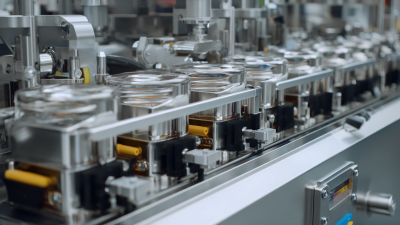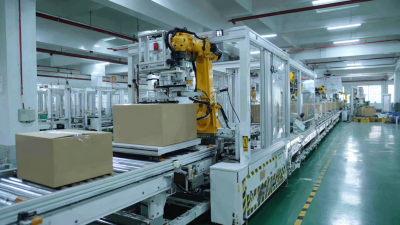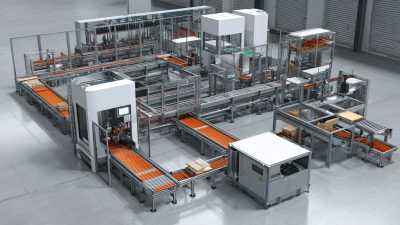Revolutionizing Efficiency in Supply Chains with Automated Packaging Technology and Industry Insights
In today's fast-paced market, the transformation of supply chains through innovative technologies is imperative for maintaining competitiveness.
 Automated packaging has emerged as a game-changing solution that enhances efficiency, reduces operational costs, and improves accuracy in order fulfillment.
By integrating advanced machinery and smart technologies, businesses can streamline their packaging processes, minimizing manual labor and human error.
Furthermore, industry insights reveal that the adoption of automated packaging not only speeds up the overall supply chain but also allows for better resource allocation and sustainability practices.
As organizations embrace this digital transformation, they are likely to see significant improvements in their supply chain dynamics, leading to increased customer satisfaction and market responsiveness.
The following discussion delves into the ways automated packaging is revolutionizing supply chains and setting new benchmarks for operational excellence.
Automated packaging has emerged as a game-changing solution that enhances efficiency, reduces operational costs, and improves accuracy in order fulfillment.
By integrating advanced machinery and smart technologies, businesses can streamline their packaging processes, minimizing manual labor and human error.
Furthermore, industry insights reveal that the adoption of automated packaging not only speeds up the overall supply chain but also allows for better resource allocation and sustainability practices.
As organizations embrace this digital transformation, they are likely to see significant improvements in their supply chain dynamics, leading to increased customer satisfaction and market responsiveness.
The following discussion delves into the ways automated packaging is revolutionizing supply chains and setting new benchmarks for operational excellence.
Harnessing Automated Packaging Technology for Streamlined Supply Chains
Automated packaging technology is reshaping the landscape of supply chains, providing companies with the ability to enhance efficiency and reduce operational costs. By integrating advanced automation systems, businesses can streamline their packaging processes, ensuring that products are securely and efficiently packed without the typical delays associated with manual labor.
This technology not only speeds up production but also minimizes human error, leading to a more reliable supply chain overall.
Moreover, harnessing these innovations allows for real-time data insights that empower businesses to make informed decisions. Automated systems generate detailed analytics, helping companies monitor their supply chain performance and identify bottlenecks swiftly. As a result, organizations can adapt their strategies to meet changing demands, optimize inventory levels, and improve customer satisfaction. In an increasingly competitive market, leveraging automated packaging technology is a critical step towards building a resilient and responsive supply chain.
Key Benefits of Integrating Automation in Packaging Processes
Integrating automation in packaging processes offers significant benefits that can transform supply chains. One of the primary advantages is increased efficiency. Automated systems can operate continuously without fatigue, thereby accelerating production rates and reducing the time required for packaging. This results in faster turnaround times for products and enables companies to meet consumer demands more effectively. Furthermore, automation minimizes human error, ensuring a higher degree of precision in packaging, which is critical for maintaining product integrity and consistency.
Another key benefit is cost-effectiveness. While the initial investment in automated packaging technology may be substantial, the long-term savings can be considerable. By reducing labor costs and minimizing waste through optimized packaging designs, companies can significantly lower their operational expenses. Additionally, automated systems can enhance scalability, allowing businesses to quickly adjust their production capabilities in response to market changes without the need for extensive retraining or hiring. This agility not only strengthens their competitive edge but also supports sustainable practices by optimizing material usage and reducing excess inventory.
Industry Insights: Trends Shaping the Future of Supply Chain Efficiency
The future of supply chain efficiency is increasingly being shaped by several key trends that are transforming how businesses approach logistics and operations. One major trend is the rise of automation, particularly through advanced packaging technology, which streamlines processes and minimizes human error. Automated systems enable companies to optimize packaging sizes, reduce waste, and enhance shipping accuracy, ultimately leading to faster turnaround times and improved customer satisfaction.
Additionally, sustainability is becoming a critical driving force in supply chain strategies. Companies are now prioritizing eco-friendly packaging solutions and processes that minimize their carbon footprint. This not only meets consumer demand for greener practices but also aligns with regulatory pressures for sustainability. As a result, businesses are investing in innovation and technology that support these goals, such as recyclable materials and energy-efficient machinery, thereby ensuring that they remain competitive in an ever-evolving marketplace.
Revolutionizing Efficiency in Supply Chains with Automated Packaging Technology
| Trend | Description | Impact on Efficiency | Technology Used | Projected Growth (%) |
|---|---|---|---|---|
| Automated Packaging | Integration of robotics in packaging processes. | Reduces labor costs and increases speed. | Robotics, AI | 20% |
| Smart Inventory Management | Real-time tracking of inventory levels. | Minimizes stockouts and excess inventory. | IoT, Cloud Computing | 15% |
| Data Analytics | Using data analytics to forecast demand. | Improves decision-making and reduces waste. | Big Data, AI | 25% |
| Sustainable Packaging Solutions | Implementing eco-friendly materials. | Enhances brand image and meets regulatory requirements. | Biodegradable materials, Recycled plastics | 30% |
| Blockchain for Transparency | Tracing products throughout the supply chain. | Enhances trust and accountability. | Blockchain Technology | 18% |
Practical Tips for Implementing Automated Solutions in Packaging
Implementing automated solutions in packaging is becoming increasingly vital for businesses aiming to enhance efficiency and sustainability. As the retail ready packaging market is projected to see a robust growth rate of 6.0% from 2024 to 2030, companies must adopt automation technologies that streamline their packaging processes while adhering to environmental standards. By integrating advanced machinery and technologies, businesses can reduce labor costs and the risk of errors, ultimately leading to faster production times and improved product quality.
To effectively implement these automated solutions, companies should start by assessing their current packaging processes to identify areas that can benefit from automation. Educating staff on new technologies and ensuring proper training is critical to leverage the full potential of these systems. Additionally, seeking insights from industry professionals can provide valuable guidance on best practices for automation, ensuring a seamless transition and maximizing the return on investment. This strategic approach not only supports operational improvements but also enhances the company's commitment to sustainability, which is increasingly demanded by consumers.
Automated Packaging Technology Impact on Supply Chain Efficiency
This bar chart illustrates the estimated efficiency improvements in supply chains after implementing automated packaging technology across various industries. Data indicates significant reductions in processing times, labor costs, and errors.
Overcoming Challenges: Ensuring Smooth Transition to Automated Systems
The transition to automated packaging systems in supply chains presents significant challenges, yet the potential benefits are immense. According to a report by the International Data Corporation (IDC), automation can boost overall efficiency by up to 30%, while also reducing costs by nearly 25%. However, companies often face hurdles related to technology integration, employee training, and resistance to change. Addressing these issues is vital to ensure a smooth transition.
To effectively implement automated systems, organizations must prioritize training their workforce. The World Economic Forum emphasizes that approximately 85 million jobs could be displaced due to automation, yet 97 million new roles could emerge emphasizing the need for upskilling. Companies should establish comprehensive training programs that not only equip employees with the necessary skills to operate new technologies but also foster a culture of adaptability and innovation. Additionally, engaging employees early in the process can help mitigate resistance and facilitate a smoother integration of automated packaging solutions.
Related Posts
-

5 Essential Tips to Optimize Your Automated Packaging Machine Efficiency
-

Unlocking the Potential of Best Food Packaging Machines Through Comprehensive Technical Specifications and Step by Step Guidelines
-

What is the Impact of Best Packaging Equipment on Supply Chain Efficiency
-

Unleashing the Power of Best Automatic Packaging Machines from China's Leading Manufacturers
-

Choosing the Right Manufacturer for Best Automated Packaging Solutions in the Industry
-

10 Effective Tips for Optimizing Your Packaging Equipment Strategy

